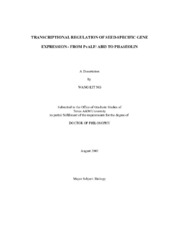| dc.description.abstract | The phaseolin (phas) promoter drives the copious production of transcripts encoding
the protein phaseolin during seed embryogenesis but is silent in vegetative tissues when a
nucleosome is positioned over its three phased TATA boxes. Transition from the inactive
state in transgenic Arabidopsis leaves was accomplished by ectopic expression of the
transcription factor PvALF (Phaseolus vulgaris ABI3-like factor), and application of
abscisic acid (ABA). PvALF belongs to a family of seed-specific transcriptional activators
that includes the maize viviparious1 (VP1) and the Arabidopsis abscisic acid-insensitive3
(ABI3) proteins. The major goal of the study is to gain insight to the regulation of
seed-specific gene expression in three different aspects. First, since ABI3 (homolog of
PvALF) is involved in ABA-mediated expression of several seed-specific protein genes in
Arabidopsis, understanding its transcriptional regulation will provide insight to the
mechanism by which PvALF expression is controlled. To achieve this, ABI3 promoter
deletion analysis using either $-glucuronidase (gus) or green fluorescent protein (gfp)
reporter gene fusions have identified various regulatory regions within the ABI3 promoter including two upstream activating sequences and a minimal seed specific expression region.
In addition, a 405 bp 5' UTR was shown to play a negative role in ABI3 expression, possibly
through post-transcriptional mechanisms. Second, placement of PvALF expression under
control of an estradiol-inducible promoter permitted chronological ChIP analysis of changes
in histone modifications, notably increased acetylation of H3-K9, as phas chromatin is
remodeled (potentiated). A different array of changes (trimethylation of H3-K4) is
associated with ABA-mediated activation. In contrast, H3-K14 acetylation decreased upon
phas potentiation and increased on activation. Whereas decreases in histone H3 and H4
levels were detected during PvALF-mediated remodeling, slight increases occurred
following ABA-mediated activation, suggesting the restoration of histone-phas interactions
or the redeposition of histones in the phas chromatin. The observed histone modifications
thus provide insight to the factors involved in euchromatinization and activation of a plant
gene. Finally, ectopically expressed ABI5 and PvALF renders the activation of phas
ABA-independent, suggesting ABI5 acts downstream of ABA during phas activation. | en |


